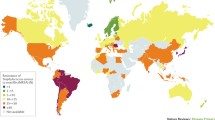Abstract
IT is probable that antibiotic-resistant variants of bacteria arise by spontaneous mutation, and their further spread depends upon selective factors in the environment. Thus an antibiotic-resistant variant has a greater chance of survival when growing in the presence of the antibiotic, and this would explain the increase in the number of penicillin-resistant strains of Staphylococcus pyogenes isolated from hospital patients that has occurred since the introduction of the antibiotic1.
Similar content being viewed by others
References
Fusillo, M. H., Roerig, R. N., and Ernst, K. E., Antibiotics and Chemotherapy, 4, 1202 (1954). Knight, V., and Collins, H. S., Bull. New York Acad. Med., 31, 549 (1954). Wallmark, G., Acta Soc. Medic. Upsal., 59, 209 (1953).
Gould, J. C., and Allan, W. S. A., Lancet, ii, 988 (1954). Rountree, P. M., et al., Med. J. Austral., i, 528 (1956).
Rountree, P. M., and Barbour, G. H., J. Path. Bact., 63, 313 (1951).
Author information
Authors and Affiliations
Rights and permissions
About this article
Cite this article
GOULD, J. Origin of Antibiotic-Resistant Staphylococci. Nature 180, 282–283 (1957). https://doi.org/10.1038/180282b0
Issue Date:
DOI: https://doi.org/10.1038/180282b0
- Springer Nature Limited





